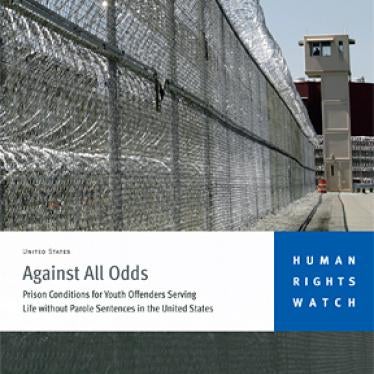(Washington, DC) – The Supreme Court decision on June 25, 2012, barring the mandatory sentencing of juvenile offenders to life without parole recognizes children’s capacity for change. It also recognizes their distinct status from adults under international human rights and constitutional law.
The court’s ruling in Miller v. Alabama and Jackson v. Hobbs brings the United States closer to being in line with the rest of the world. No other country sentences people to life without parole for offenses they committed before the age of 18, even for homicide offenses. The ruling makes any mandatory sentence of juvenile life without parole unconstitutional and recognizes that in other cases in which life without parole may still be an option, judges should take into account the differences between children and adults.
“With this landmark ruling, the United States is no longer an egregious outlier among nations in requiring judges to put kids in prison until they die there,” said Alison Parker, US program director at Human Rights Watch. “The court did not go far enough, still allowing the sentence in rare cases, but it recognized that it is nearly impossible to be certain that any child is beyond redemption – and that the US criminal justice system needs to change to reflect this fact.”
Human Rights Watch estimates that over 2,500 people are serving life without parole for crimes they committed while a juvenile, in 38 states and federal prisons.The ruling should affect all cases in which courts did not take a youth’s age and status into account when sentencing – including cases in 29 states with mandatory sentencing schemes. In such cases, youth offenders should receive new sentences allowing for regular and periodic review of their eligibility for parole, and state legislatures should act to ensure that all youth offenders have access to such reviews.
Since 2004, through numerous interviews and in-depth data analysis, Human Rights Watch has been investigating the situation and conditions of confinement of youth sentenced to life without parole throughout the United States, and in particular states such as California and Colorado.
This research has found that there are stark racial disparities in the imposition of the sentence, with black youth serving life without parole at a per capita rate that is 10 times the rate of white youth.
Human Rights Watch also estimates that 59 percent of the youth serving life without parole in the United States received this sentence for their very first offense – they had no juvenile or adult criminal record prior to the offense that resulted in their life sentence.
Moreover, often youth sentenced to life without parole were not the primary actors in the crime: they did not pull the trigger or physically commit the homicide. A significant number of these cases involved an attempted crime gone awry – a botched robbery attempt, for example – rather than a murder planned by the youth in advance.
“Racial disparities and the excessive nature of the sentence in light of many youths’ criminal histories are important reasons to question its fairness,” Parker said. “But the sentence is inappropriate in every case – mandatory or not – because both constitutional and international human rights law recognize that children must be treated differently from adults.”
Oversight and enforcement bodies for two treaties that bind the US as a party – the International Covenant on Civil and Political Rights and the International Convention on the Elimination of All Forms of Racial Discrimination – have found that the practice is a clear violation of US treaty obligations.
This international consensus is reflected in the US Supreme Court’s previous rulings in Roper v. Simmons – which found unconstitutional the imposition of capital punishment on juvenile offenders, and Graham v. Florida – which held that juvenile offenders cannot be sentenced to life without parole for non-homicide offenses. The court has recognized, and has affirmed in its decision on June 25, that the differences between juveniles and adults make suspect any conclusion that a juvenile offender can be judged beyond rehabilitation at such a young age. After the Supreme Court’s decision, there is no longer any doubt that the US Constitution, like international human rights law, draws a clear line between juveniles and adults when it comes to matters of crime and punishment.
“The Court has recognized today what every parent knows – kids are different and are capable of tremendous growth and transformation,” Parker said. “Now, it is up to judges and state legislators to ensure that every child offender has a meaningful chance to work toward rehabilitation, to periodically demonstrate their achievements, and, if merited, to earn their release from prison.”








